Untitled Document
By MANFRED ERTEL, ERICH FOLLATH, HANS HOYNG MARION KRASKE, GEORG MASCOLO AND
JAN PUHL
Since Sept. 11, the CIA has played a vital role in the war on terror.
But what role is it? Operating in the shadows, American secret services have
been given wide-ranging powers by the Bush Administration. And they include
murder, abduction and torture.
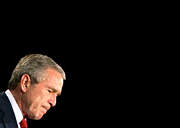 |
|
Questions about the CIA and Bush's handling of the war on terror have been dogging the president of late.
|
It's Saturday, Sept. 15, 2001, four days after the terror attacks in New York
and Washington. US President George W. Bush withdraws with his closest advisors
to Camp David in order to escape the chaos of the week and to develop the first
plans to confront the new and unprecedented challenge facing the United States.
In the afternoon, then CIA head George Tenet distributes a file to all participants
of the crisis summit. It's called "Going to War." Inside are the first
rough outlines of the coming war against terrorism. In the upper left corner
of the file's cover, there is a red circle inside of which is a portrait of
Osama bin Laden with a black line drawn through it.
Tenet wants to go on the offensive. And his list of priorities is ambitious.
Goal number one: Destroy al-Qaida and close off the terror group's zones of
safety, wherever they might be.
According to Bob Woodward in his book "Bush at War," this is a list
with wide-ranging powers, granted to authorities battling worldwide terror.
And Tenet does not hold back. He requests that his agents be given the go-ahead
to eliminate al-Qaida wherever the CIA comes across its members. He wants carte
blanche for clandestine operations without having to first go through the long
process of having them authorized. In addition, CIA agents should again have
authority to kill -- a power withdrawn from US intelligence agents in 1976 by
then-President Gerald Ford.
Also on Tenet's wish list is a request for hundreds of millions of dollars
to buy help from foreign intelligence services. Specifically, Tenet thought
agents from Egypt, Jordan and Algeria could help the CIA track down and eliminate
al-Qaida.
Three days later, Bush signs a Presidential Directive whose exact wording only
a very few Americans know until this day. Point for point, the demands made
by the CIA were granted, and with that, the document became the first shot fired
in the worldwide war on terror. Bush ordered the CIA to be the first on the
new front. America's secret agencies were unleashed.
Four years later, America's intelligence services -- and especially the CIA
(the "flagship of the business ... where you come if you want the gold
standard," according to the agency's new director Porter Gosss) -- have
become one of the most controversial weapons in the fight against terrorism.
The most powerful army in the world has become an occupying power in Iraq and,
by its mere presence, attracted a whole new generation of mujahedeen; but Bush's
intelligence community has fought its part of the battle under the apparent
motto, "The end justifies all means."
Washington's secret agents, whose disdain for international legal norms right
up through the 1970s gained them a reputation for being ugly Americans, are
back on the international political stage. Not everybody is happy to see them.
And Bush is using all tools at his disposal. Measured by sheer numbers and capability,
America's gigantic secret service apparatus appears just as omnipotent as its
military: Fifteen agencies with 200,000 employees and a yearly budget of some
$40 billion. The sum represents more than most countries even spend on their militaries.
The satellites of these agencies can read license plates from space -- and the
newest generation of these advanced spy satellites are just as sophisticated as
the Hubble Space Telescope. But instead of peering into the depths of the universe,
they are look down at what's happening here on Earth.
Every day, analysts from this secret army deliver their findings to their superiors
and, in the form of the Presidential Daily Briefing, to President Bush himself.
It's a sort of super-secret daily newspaper -- with severely limited circulation
-- comprising between 12 and 30 pages. It's the most important thing you have
to read every day, Bush Senior -- himself head of the CIA for a year -- told
his son when Bush Junior took office.
But the secret war doesn't end with America's spy agencies. Likewise in the
shadows -- sometimes operating within international law, sometimes outside it
-- are the special forces of the American military. Secretary of Defense Donald
Rumsfeld sends them on missions across the globe; indeed they may, some say,
already be operating inside of an Iran that continues its pursuit of nuclear
weapons. Ashton Carter, assistant secretary of defense under Bill Clinton, says
he would be "surprised and disappointed" if covert measures were not
already under way against Iran's armaments program.
And where American personnel can't go, the National Security Agency's (NSA)
worldwide network can eavesdrop. The NSA routinely listens in on the United
Nations in New York -- and UN General Secretary Kofi Annan, at least for a while,
was one of the agency's number one targets, says James Bamford, a leading expert
on the NSA.
One of the newest weapons in the secret service arsenal is called "geolocating."
When satellites locate a suspect through a mobile phone signal, for example,
special forces or warplanes can quickly strike. The technology has become so
precise that mobile phones can be located to within one meter.
Indeed, the ability to locate a target precisely was instrumental in killing
al-Qaida military head Mohammed Atif in his house near Kabul, in November 2001,
or in the arrest of bin-Laden aide Abu Subeida in Pakistan. But the system also
makes grave mistakes. In 2002 in Afghanistan, for example, hastily scrambled
bombers dropped their ordnance on a wedding party instead of on a targeted meeting
of terrorists.
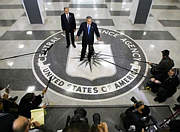 |
|
US President Bush with CIA head Porter Goss.
|
CIA head Goss, himself a CIA agent for 10 years before he went into politics,
encourages the risk-taking by his agents. "And when it goes wrong, I will
support you," he has told them. He sends his agents with deadly powers and
backpacks full of dollars into operations all over the world where they also have
the authority to call in air power. Or, alternatively, they can call in a Predator
-- drones armed with laser-controlled Hellfire rockets and which can be steered
from half a world away using a simple joystick.
In the 1980s and '90s, secret operations in foreign countries became rarer,
and analysis was emphasized. But that was the old CIA -- an organization former
officer Melissa Boyle has derided by saying the days of James Bond are over.
President Bush has repeatedly warned Americans that the new enemy confronting
the US is totally different than all those that have come before.
This warning represents the birth of the new CIA -- an agency that should strike
fear into the hearts of its enemies.
So is the CIA on the road to re-establishing the notoriety it for so long had
in the Third World? That of a frightening, secret power that kidnapped politicians,
bought mercenary troops and toppled governments at will merely because Washington
didn't approve of them?
Shortly after the agency's founding on July 26, 1947, by President Harry Truman,
the CIA had already made the world its playground. It began deciding who were
the good guys and who were the bad guys and began to punish the bad guys at
the order of the White House.
The "firm" had a license to kill, and used it during the Cold War
against a Soviet enemy that was at least as brutal. In the 1960s, the CIA developed
a highly poisonous arrow that was supposed to leave no traces whatsoever during
an autopsy. It also experimented with training dolphins to deliver explosives
to a given target.
But these were hollow victories. Mixed in with the successes were disastrous
missions abroad and embarrassing mistakes at home. The combination led to the
CIA becoming more of a burden then a help. The nation was horrified to learn
that President Richard Nixon used former agents for the Watergate break-in;
Americans were disgusted by the government's spying on tens of thousands of
citizens critical of their government; the term "America's Gestapo"
began to make the rounds.
The result was a reigning in of Big Brother. In 1974, a law went into effect
requiring that all clandestine operations abroad had to be rubber-stamped by
Congress. Intelligence services began concentrating almost exclusively on technological
data-gathering -- and thus largely stayed out of the Iranian revolution. In
an Afghanistan fighting against the USSR, the CIA failed to appreciate that
the mujahedeen -- generously supplied with American arms and money -- were not
only fanatic opponents of the Soviets, but were also against the American "crusaders."
Part II: Cheney goes to the dark side
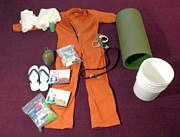 |
|
Standard supplies issued to prisoners at Guantanamo.
|
Indeed, the pact with the Islamist warriors -- in combination with an almost blind
faith in the Pakistani secret services -- played a large role in the development
of the Taliban and al-Qaida both. Afghanistan became Bin Laden Land.
The fact that Sept. 11 resulted in major changes to the American spy services
was thus hardly a surprise. What was surprising, though, was the speed with
which they regained their bad old reputation. The list is growing once again:
allegations that the CIA handed out large sums of money in Venezuela in an effort
to topple Hugo Chavez; and a growing number of terrorists executed by the agency's
drones.
In Yemen, a Hellfire rocket fired by a CIA Predator took out the alleged ring-leader
of the 2000 attack on the USS "Cole." The CIA killed the Egyptian
Hamsa Rabia -- the al-Qaida number three -- in Pakistan not far from the Afghanistan
border using the same weapon earlier this month.
Vice President Dick Cheney, who even on his good days increasingly resembles
an old-style Soviet general secretary, publicly announced the CIA's change of
direction. One has to operate in the shadows, he says. In order to defeat the
terrorists, America's agents "have to work the dark side, if you will."
If the enemy doesn't play by the rules, then we won't either, is Cheney's message.
The war in Afghanistan, and the hunt for bin Laden, showed to what extent the
CIA was willing to use its new powers. Cofer Black, the coordinator for counter-terrorism,
demanded the head of the al-Qaida boss and meant it quite literally. The gruesome
trophy should be sent express -- and "on ice" -- to Washington, he
said. Bush also takes the hunt for the terrorists personally: In his desk is
a list of al-Qaida leaders that he crosses off each time one of them is captured
or killed.
Originally, the CIA likely considered taking out all al-Qaida bigwigs using hit
teams -- the way Israel's Mossad killed those responsible for the 1972 Olympic
bloodbath in Munich, or executed the military leaders of Hamas in the Gaza Strip.
But then, the concern won out that even as al-Qaida leaders were erased, unknown
terror groups could strike again.
A new idea gained credence -- that of capturing al-Qaida members alive in order
to interrogate them and profit from information about the organization and its
plans. Information was the only way to combat the danger of new attacks.
Exactly how far this system has gone to gather information -- and how widespread
its secret prisons are -- is known by only a very few Americans. At the request
of Cheney, only the chairs and vice-chairs of the intelligence committees in
the Senate and the House are informed. Such information is top secret, Cofer
Black told a congressional group in September 2002. "This is a highly classified
area," he said. "All I want to say is that there was before 9/11 and
after 9/11. After 9/11 the gloves come off."
All congressional and legal investigations into the abuse of prisoners by Americans
have been performed, so far, without the benefit of insight into the practices
of the CIA. Not even the Red Cross has been allowed to visit a number of high-value
prisoners -- from Khalid Shaikh Mohammed, the planner of the attacks on New York
and Washington, to Ibn al-Sheikh al-Libi, the head of an al-Qaida training camp.
They have just disappeared.
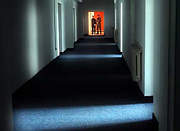 |
|
Romanian military staff stand at the end of a corridor on the Mihail Kogalniceanu airbase, east of Bucharest.
|
For those in control of the scattered CIA prisons, there is no higher power.
The Republican John D. Rockefeller, a member of the Senate intelligence committee
complains that the government has made it clear that all those who would demand
an element of control over these areas are to be criticized as being unpatriotic.
Although the exact extent of the CIA's new powers remains unclear, enough is
known to determine that human rights are being violated, along with international
conventions and treaties. Targeted liquidations, the kidnapping of suspects
abroad and the delivery of prisoners to other country's secret services are
definite examples of such violations.
Above all, interrogation experts from the CIA are still equipped with six notorious
torture tools with which they can force prisoners to talk. To define them, government
lawyers have chosen harmless-sounding euphemisms: the "Attention Grab"
describes the practice of grabbing the shirt of a prisoner and shaking him --
only, of course, to get his attention. Then there's the "Attention Slap"
and the "Belly Slap." Doctors recommend not using the fist out of
fear of causing internal injuries.
Worse, though, is "long time standing," whereby prisoners are forced
to stand uninterruptedly for as long as 40 hours. Rumsfeld's boorish observation
-- that he too has to stand for hours during his workday -- seems rather cynical.
The keyword "cold cell" describes a practice of cooling prisoners'
cells down to 10 degrees Celsius (50 degrees Fahrenheit) and then repeatedly
pouring cold water over them. But it's "waterboarding" that has generated
the most outcry -- a form of water torture which leads the prisoner to believe
that he is drowning or suffocating. Only a few seconds of waterboarding are
necessary to get the most prisoners to talk. Khalid Sheik Mohammed is said to
have held out a mere two minutes and a half. Senator Carl Levin, a Democratic
member of the Senate intelligence committee, is demanding transparency. "It's
totally unacceptable that documents that are requested from the CIA have not
been forthcoming," Levin said during hearings held by a panel investigating
the Abu Ghraib abuses.
Part III: Tortured to death by the CIA
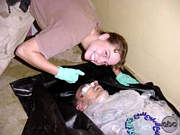 |
|
US soldier Sabrina Harman with the "Iceman," an Iraqi prisoner killed in Abu Ghraib.
|
It is likely that nobody will ever now how many terror suspects abducted by the
CIA have died in the torture chambers of Egyptian, Algerian, Syrian or Saudi Arabian
prisons. When everything possible has been used to extract every last bit of information,
the suspect's trail often vanishes.
In fact, it is generally good news for prisoners when they end up in prisons
controlled directly by the CIA. There, "only" those methods of Torture
Light described above are used. But those examples of prisoners dying while
in American hands show just how quickly things can get out of control.
In November 2002, the guards at a secret prison -- called "Salt Pit"
-- located not far from Kabul were ordered to strip one uncooperative Afghan
prisoner naked, chain him to the concrete floor of his cells, and leave him
there in below-zero temperatures all night. In the morning, he was dead. After
a hurried autopsy, the guards quickly buried him in an unmarked grave on the
edge of the city.
But only one single man connected to the CIA, David Passaro, has been prosecuted
by a US court. Passaro, who was on contract with the CIA, stands accused of
beating an Afghan prisoner to death during an interrogation in June 2003 on
the US military base at Bagram.
The most spectacular case where a prisoner died at the hands of the secret
services took place in Abu Ghraib. It's a case that has become infamous the
world over by virtue of the private photos made by American soldiers for their
own enjoyment. Alongside the pictures of sexual humiliation, there is one particular
photo that stands out: that of the abused corpse of a man -- wrapped in plastic
and packed in ice -- above which the American soldier Sabrina Harman poses with
a wide grin.
The corpse has come to be known as "The Iceman." The case will likely
haunt the CIA for many years to come as it shows exactly what happens when a
legitimate state power is combined with contempt for humanity.
On Nov. 4, 2003 the special forces unit the Navy Seals got a tip-off and searched
a house in a Baghdad suburb for Manadil al-Jamadi. The man was thought to have
delivered explosives for a terrorist attack. Jamadi struggled a great deal when
arrested. He didn't exactly come out of the tussle unscathed. He had a black
eye and a cut on his face, but nothing fatal.
The Seals first brought their prisoner to the Navy camp at Baghdad's airport.
Here, according to one eye witness, a CIA interrogator "pushed him in the
chest with all his strength." The prisoner was then stripped naked and
cold water was thrown all over him. "We'll grill you on an open fire if
you don't talk," threatened one of the CIA men. "I'm dying, I'm dying,"
al-Jamadi moaned. "You're going to wish you were dead," replied the
interrogator.
They then transported him to Abu Ghraib, where CIA employee Mark S. took him
into custody. Forty-five minutes later he was dead.
The manner in which al-Jamadi died is known, among experts, as a "Palestinian
hanging." It is regarded across the world as an outlawed practice. The
prisoner is hung onto a high window by his arms, with his hands tied behind
his back. This means that he can't make the slightest movement without experiencing
extreme pain. Al-Jamadi collapsed during questioning. "He's only pretending
to be dead," S. is reported to have said -- incorrectly, as it turned out.
Al-Jamadi was indeed dead.
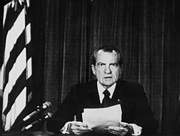 |
|
US President Richard Nixon resigning as a result of the Watergate break ins.
|
The case had still not been brought to court even two years after the incident
took place. Paul McNulty, the lawyer responsible for the eastern district of
Virginia, which had jurisdiction over the CIA headquarters of Langley, is trying
to, if not cover up the case, at least drag it out. McNulty is known as a Republican
and supporter of Bush. In the meantime he has been nominated as deputy to Minister
of Justice Alberto Gonzales, the man who helped make American torture socially
acceptable.
The official line of the US government is to call such practices "robust
treatment," rather than torture. That, for example, allowed Secretary of
State Condoleezza Rice, on her most recent European tour, to deny that America
carries out torture. The director of the CIA Porter Goss referred to the interrogation
methods his agents used as "unique and innovative" methods of making
prisoners talk.
But Republican Senator John McCain, who was tortured as a prisoner of war in
Vietnam, says that practices such as waterboarding are nothing more than mock
executions, which, regarded as torture, are outlawed all over the world. "In
my view," he says, "to make someone believe that you are killing him
by drowning is no different than holding a pistol to his head and firing a blank.
I believe that it is torture, very exquisite torture."
It is exactly because of the gruesome treatment of prisoners that made it expedient
to remove suspects as much as possible from the responsibility of American judges.
This practice gave birth to the Guantanamo prisoner camp, as well as a whole
range of so-called black sites, or secret interrogation areas, where the CIA
keeps its most valuable prisoners under continuous observation. These mobile
secret camps came into being exactly because the US government feared that the
courts would eventually demand fair trials even for the inmates of the prisons
on Cuba.
Apparently one of the first black sites was in Thailand. When news leaked out,
the government in Bangkok demanded the withdrawal of the interrogation experts
from Langley.
For a while the CIA even dreamt of having its own Alcatraz, and looked into
setting up a high-security prison in Lake Cariba in Zambia. Worries about the
reliability of the government in Lusaka put paid to this scheme, but the environment
would have been ideal. John Radsan, a former CIA lawyer, commented on his ex-employer's
prisoner program by saying "It's the law of the jungle. And right now we
happen to be the strongest animal."
The CIA then seems to have turned to the states of Eastern Europe, regarded
as particularly acquiescent to Washington. They like to team up with Europe
when it comes to economic development, but as far as security goes, they rely
on cooperation with the United States.
This explains why Europe became the central hub for the transport of CIA prisoners.
Hundreds of the now infamous flights used the airspace between Greenland in
the north and the Azores in the south, and the Atlantic coast of Ireland in
the west and Romania in the east. There is hardly a country which was not used,
and more details are constantly being unearthed.
Part IV: Dark flights across Europe
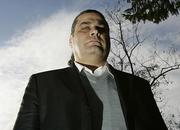 |
|
German citizen Khaled el Masri was abducted by the CIA in Macedonia.
|
An odd alliance of human rights organizations, state government observers, journalists
and plane spotters has created a close-meshed network of indicators which raises
more and more questions about the US secret services and their dubious practices.
Not to mention the stupidity or acquiescence of their European allies.
On Jan. 22 of the previous year, for instance, an unsuspicious-looking Boeing
737 with the identity number N313P landed at the airport of Son Sant Joan in
Palma, Mallorca. The aircraft came from Algiers and was on the way to Skopje.
There it was boarded, the next day, by the Lebanese-born German citizen Khaled
al-Masri, who had been abducted by CIA agents and was being flown to the Afghan
capital Kabul.
When it became clear that the secret service had captured the wrong man, bitter
arguments within the CIA broke out on how to deal with the incident. It was
the then National Security Advisor Condoleezza Rice, who last week got such
a battering all over Europe for the CIA kidnappings, who ordered the German's
release.
The illegal prisoner shuttle only came to light in March, when human rights
organizations brought the case of "abduction, illegal arrest and torture"
to the local courts. The government in Madrid had no intention of admitting
to collaboration with the Americans. The new socialist foreign minister Miguel
Angel Moratinos attempted to smooth over the public outcry and protect the previous
conservative government with a "message of peace and calm."
But Moratinos had every cause for concern. According to recent official inquiries,
US aircraft, commissioned by the CIA, are thought to have used Mallorca as a
stop-off point at least 15 times in the last two years. And officials report
nine landings on the Canary Island of Tenerife.
Investigators suspect that the incriminated Mallorca plane took at least 19
cross-border trips for the United States. Apart from landing at Palma, the passenger
jet also stopped off in Ireland, Larnaka in Cyprus and in the Swedish town of
Orebro.
A mission on Sept. 22, 2003 is especially interesting. On this particular Monday
a CIA-operated Boeing took off from Kabul and made its way to the northern Polish
airport of Szymany. It then flew on to the Romanian staging post of Mihail Kogalniceanu
on the Black Sea. Critics of the CIA, such as the human rights organization
Human Rights Watch, have had their eyes on both arms bases for a while now.
Only a few days ago, according to reports by the US channel ABC, high-ranking
al-Qaida fighters are thought to have been shipped out of Europe in time for
Secretary Rice's visit. One of these involuntary travelers was Ramzi Binalshibh,
who helped plan the attack on the World Trade Center. The new destination: unknown
dungeons "somewhere in North Africa."
In Poland, cooperation with the CIA has always been strongly denied. The new
government refers to the explanation given by the outgoing president Kwasniewski.
"Such a prison has never existed," he said.
Really? The camp in the small town of Szczytno in Mazury is certainly tailor-made
for secret missions. Official flights to what has become Poland's most famous
airport stopped long ago. Gone are the big plans whose remnants can only be
seen in the multi-lingual signs: "Welcome to the international airport
of Szczytno-Szymany."
Only private aircraft land and take off here. When, for example, King Juan
Carlos of Spain wants to do a bit of hunting in the forests full of wild beasts.
Or, possibly, when American friends have urgent business which needs to be dealt
with?
"The airport is always ready for action, the technical equipment is all
intact," says the uniformed border guard. Local residents report that black
minivans with darkened windows and military markings are always driving by.
Vehicles like this belong to the official fleet of the military unit 2669, 20
kilometers away in Stare Kiejkuty.
Two barbed wire fences separate the tiny village from the site with its watch-towers,
barriers and far-off red and white radio masts. Photos are strictly prohibited
and Polish journalists have had film and memory chips confiscated over the last
few days.
Unit 2669 is officially the "training center for news service cadres."
And the fact that it is so near, politically to the new American allies, and
geographically to the airport, makes the site of particular interest. Respected
village resident Krzysztof Uminski, 45, the last farmer in the area, does not
like answering pushy questions. After all, he says, most of the other villagers
live from "work provided by the state." Only hesitatingly does he
admit what that means. The spy school is the only major employer in the remote
area surrounding the lake.
The flights via Spain are not the only ones to have attracted attention. A
Gulfstream with the identification number N85VM also keeps cropping up as a
CIA transporter in international log-books and with human organizations. On
April 12, 2004 it took off from Guantanamo with an unidentified cargo. First
stop was Spain. The explosive mission's destination was Bucharest.
The airport of Mihail Kogalniceanu, often called simply "MK" by American
allies, lies about 200 kilometers from the Romanian capital. The US military
has been using the maneuvering area as a supply base for the Iraq war since
2002. Last week Secretary of State Condoleezza Rice signed an agreement with
the government in Bucharest that would allow the USA to keep a base for troops
there long-term. The agreement is only a logical next step. Parts of the camp
have been American-only military areas for years, as the former minister for
defence, Ioan Mircea Pascu, was forced to admit.
British journalist Stephen Grey counts 210 dubious flights to England alone,
by noting official records of flights commissioned by the CIA. There are thought
to be dozens more, according to research in Ireland and Portugal. Landings have
also apparently happened in Prague, Helsinki and Budapest. Estonia, the Netherlands,
Iceland, Norway and Denmark all lie on the flight-path.
On Feb. 17, 2003 in Milan, a CIA commando force abducted the radical Islamist
Abu Omar in "a completely illegal act", as observers describe it,
and flew him out of the country. Extradition warrants have been made out for
22 CIA pursuers.
But the central hub for Europe was Germany: the Americans used the Frankfurt
Rhein-Main Airbase for 437 flights. It was from here that Hercules flight N8183J
took off, which on Jan. 21, 2003, set off an alarm with the Austrian air force.
Two Austrian chaser jets were scrambled. Identifying the plane (built by the
US company Tepper Aviation) as a "pseudo-civilian aircraft," the pilots
let it pass.
Part V: No prosecuting; no killing
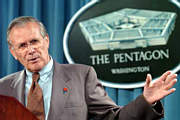 |
|
Defense Secretary Donald Rumsfeld has sent US special forces all over the world
|
The fact that the planes are deterred from using neutral airspace was also noticed
by Sweden. A great deal of anti-US distrust has brewed in Sweden since the CIA
brought two Egyptian asylum seekers from abroad in 2001, in full view of the Swedish
police -- albeit only after the Swedes had arrested the men after a tip-off from
the Americans.
Just hours later US agents, in a Gulfstream V business jet (registration N379P),
landed at Bromma budget airline airport on the outskirts of Stockholm. Eight
masked men climbed out of the private jet, grabbed the Egyptians and cut their
clothing off them with knives. They gave them tracksuits to wear and covered
their heads with hoods. Swedish protests were cut short by curt gestures.
Within ten minutes the Egyptians, who were thought to belong to the group Islamic
Jihad, were on the Gulfstream, and, shortly after that, out of the country.
Swedish diplomats reported later that both have since then been tortured.
The in-house airline belonging to America's most powerful intelligence service
is the industry's worst-kept secret. CIA lawyers and the international air transport
authorities demanded that the fleet of aircraft should have proper registration.
Once someone has found out the identification numbers of these planes, it doesn't
take long to then follow their movements.
Employees of the CIA shuttle company always have run-of-the-mill names like
Steven Kent or Audrey Tailor. They never have private telephone numbers or previous
employers. Their social security numbers are brand new; their only fixed addresses
are postal boxes. These are classic "sterile identities," as the CIA
calls them.
Former CIA officer Robert Baer, one of the most successful secret service Middle
East experts, described the arrangement with disarming openness: "There
is a rule inside the CIA that if you want a good interrogation and you want
good information you send the suspect to Jordan, if you want them to be killed
or tortured to death you send them either to Egypt or Syria, and you never see
them again."
Now hardly any country is willing to take in the sorry caravan of CIA officers
and their prisoners. Everyone fears retribution from al-Qaida.
Even before the spread of the latest CIA scandal, the new use of power showed
itself to be counterproductive in many ways. Admittedly there has been no major
attack on the USA since September 11 - ten attacks have been prevented all over
the world, Bush boasted in October - but the statements forced out of prisoners
under ill treatment don't help anyone, as they would never be admissible in
an American court of law. "Even Adolf Eichmann got a trial," warns
McCain. Maybe too late: a fair trial after torture is no longer possible.
That puts the CIA between a rock and a hard place. "You can't prosecute
these people, but you can't kill them either," said Michael Scheuer, the
former head of the CIA special unit which, already under Bill Clinton, was assigned
to tracking down Bin Laden. "All we've done is create a nightmare."
How damaging the program of fighting terror has become is shown by the case
of the defendant Jose Padilla in Chicago, who was accused, after his arrest,
by former Attorney General John Ashcroft, of wanting to set off a dirty bomb.
But in the end Padilla was only charged with supporting and promoting a terrorist
organization. The more serious accusations were based on statements made by
Khalid Sheikh Mohammed. The government is loath to reveal what has been discovered,
out of fear that, during the trial, the method of how these statements were
obtained would come out into the open.
There can be no doubt that the political damage caused by this prisoner ill-treatment
has long outweighed any possible use intended by such a policy. The CIA torture
scandal is on the way to becoming a second Abu Ghraib. The torture carried out
in the infamous Iraqi jails has damaged the USA's image across the world, and
destroyed its moral pretence to bring democracy and freedom to the Middle East.
For months now, Washington has been reeling with a bitter debate on how to
bring an end to the unceasing accusations of torture. The camp of Guantanamo
is also included in the debate. National Security Advisor Stephen Hadley and
Secretary of State Rice demand that UN inspectors should have the right to contact
prisoners. In Congress, politicians from both parties support the law proposed
by Vietnam veteran McCain, which would ban torture by US authorities.
But Vice President Cheney and CIA Director Goss fight, with rear-cover provided
by the White House, to provide the secret service with an exemption from this
ban on torture. It is possible they are fighting a losing battle.
Last Wednesday, in Kiev, Secretary Rice said the UN ban on torture also applied,
naturally, to American state employees. "As a matter of US policy,"
she said the United Nations Convention against Torture "extends to US personnel
wherever they are, whether they are in the US or outside the US." Since
then, speculations have been made in Washington as to whether hardliners will
step down or fight back as soon as Rice returns.
Now respected veterans of the intelligence community are joining in the debate:
Vincent Cannistraro, a former anti-terror head of the CIA and leader of the
working group which investigated the Lockerbie crash in 1988, doubts how worthwhile
statements made under torture can be. "Detainees will say virtually anything
to end their torment," he says. Burton Gerber, the former head of the Moscow
unit is convinced that torture "corrupts every society that tolerates it."
Larry Johnson, a former CIA agent and foreign ministry anti-terror expert says
"What real CIA field officers know firsthand is that it is better to build
a relationship of trust ... than to extract quick confessions through tactics
such as those used by the Nazis and the Soviets." And ex-agent Baer, whose
life was the inspiration for the Hollywood thriller "Syriana," is
even certain that "this story will destroy the CIA."
Even the interrogators have been left with nagging doubts as to the legality
of their actions -- despite all the assertions made by the government. Why else
would Washington be so adamant about keeping prisoners off American soil? Tenet
demanded guarantees, again and again, that his agents would not be hauled in
front of a court sometime in the future.
Which led to the infamous seal of approval from the Attorney General's office
and the White House, in which then Assistant Attorney General Jay Bybee confirmed
that every type of interrogation method was allowed as long as it didn't lead
to serious injuries, organ failure or death.
The current Secretary for Homeland Security Michael Chertoff also rubber-stamped
such actions. And Attorney General Gonzales made a speech to the Senate in which
he claimed that ill-treatment of prisoners was permissible as long as those
affected were not US citizens and the torture took place abroad. All three seals
of approval for torture were supported by Bush.
As a result of remaining uncertainty, the CIA demanded that the politicians
themselves take over responsibility for the treatment of prisoners in the worldwide
war on terror. "We should lock these people up," the former terrorist
hunter Scheuer said to SPIEGEL. "They declared war on us, so we are allowed
to hold them until the end of the war." He defended the basic principle
of the fight against terrorism: "We have to catch these people before they
can do more killing."
However, Scheuer also admits that America's arrogant disdain for prisoner rights
has been like "shooting your own leg." He said that in reality there
was no need for special powers or new means of interrogation. "This whole
story is a massive success for al-Qaida, because we are losing the support of
Europe, our most important partner in the fight against terror."
At the same time, however, he sees the definition of torture as relative. "There
is a difference between torture and severe interrogation methods. Torture is
pulling someone's nails out."







